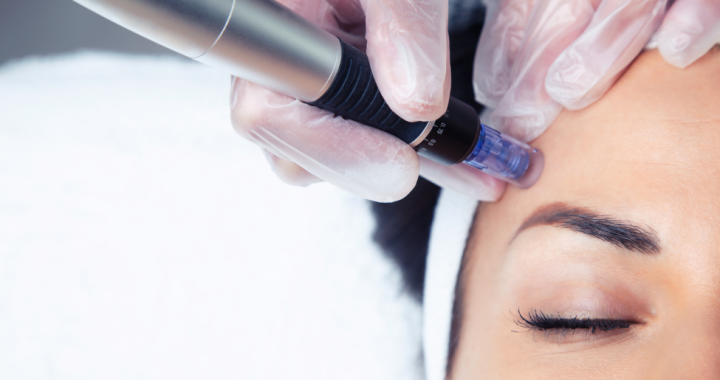Microneedling, a minimally invasive procedure used to improve your skin’s texture, continues to grow in popularity, but as its popularity grows, we see patients asking more and more questions like, “Does microneedling hurt?” and “Does microneedling hurt with numbing cream?” We understand that pain can dissuade some from a procedure, so we cover these questions and more in our blog.
What is Microneedling?
Microneedling is a cosmetic dermatology procedure used to minimize the size of pores, acne scarring, and fine lines and wrinkles. It can be used to improve your skin’s texture in many areas of the body, including your face, neck, and hands. It’s FDA-approved, minimally-invasive, and a safe and effective way to obtain a more youthful appearance.
During a microneedling procedure, a specialized pen is used to create micro-injuries, or tiny holes, in the skin. These tiny injuries stimulate the body’s natural healing process without causing excess cellular damage to the skin’s surface. The collagen produced in reaction to these micro-injuries helps to improve the texture of your skin and creates a more youthful appearance by making your skin more firm and elastic.
Now that you know what microneedling is, you’re probably asking yourself, Does microneedling work? Yes, it does. One of the reasons this procedure is so effective for so many people is because it uses the body’s natural healing response. Many patients see results within one week, but full results are seen over time as more collagen is produced while you heal.
The collagen produced because of a microneedling procedure is long lasting, but the aging process will eventually target these areas again. Many people choose to schedule a few appointments a year to maintain the results they see from microneedling.
Does Microneedling Hurt?
Although each person experiences pain differently, most compare microneedling to the feeling of an electric toothbrush being passed over your skin. Others feel pressure or as if you’re scratching an itch. Areas more susceptible to discomfort during microneedling include your jawline, forehead, and hairline as these are the more bony areas of your face.
To further decrease the chances of any discomfort, stop using products that can irritate your skin a few days before your procedure. We most often recommend patients stop using retinol or any other exfoliants, dermaplaning, and/or waxing as they can increase your skin’s sensitivity. Once your skin is healed, you can resume using these products and beauty routines.
Does Microneedling Feel Like a Tattoo?
Some people have compared the feeling of microneedling to that of getting a tattoo, though more have compared it to having fine sandpaper rubbed along your skin. The special pen used for your microneedling procedure is the same premise as a tattoo gun; however, a tattoo gun penetrates 5 layers of your skin while a microneedling pen only penetrates the top layer.
Do You Need Numbing Cream for Microneedling?
Many people are curious about numbing cream, specifically, does microneedling hurt without numbing cream? At Vujevich Dermatology Associates, we use the SkinPen, which creates hundreds to thousands of micro skin injuries per second, which can be painful without numbing cream. We use topical numbing medication during your microneedling appointment to minimize any pain you may feel during the procedure.
How Long Does Your Face Hurt After a Microneedling Procedure?
You may feel slight discomfort or a tingling sensation in the 24-48 hours following your microneedling procedure. You can moisturize with a light, calming moisturizer following your procedure to help with any discomfort.
Your dermatologist will prescribe an individualized skin care routine to begin 24 hours after your microneedling procedure. Generally you can begin to use a non-exfoliating cleanser after 24 hours. You’ll want to avoid any cleansers with active ingredients or harsh scrubbing motions when washing your face, or you may irritate your skin and reopen those tiny injuries.
To help your skin heal following microneedling, you’ll want to drink plenty of water and apply SPF often. Your SPF should be applied (and reapplied) daily for the two weeks following the procedure as your skin is extra sensitive to sun during the healing process. Our Microneedling Aftercare Guide covers other things to avoid to help reduce discomfort, including makeup and sweat.
Microneedling is a safe and effective treatment for improving the texture of your skin, reducing fine lines and wrinkles, and shrinking pores. While there are products for microneedling at home, it’s safer and more effective to have microneedling done by a trained professional.
If you’re interested in discussing more questions about microneedling with your dermatologist or would like to schedule a consultation, you can reach our team at 412-429-2570 or visit our contact page to book your appointment. You can also follow us on Facebook to see what’s new in the world of dermatology.

